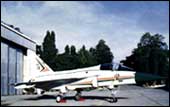Home > News > Report
LCA breaks sound barrier during test flight
Fakir Chand in Bangalore |
August 01, 2003 16:21 IST
Last Updated: August 02, 2003 00:44 IST
 For the first time in its history, the Light Combat Aircraft, christened Tejas, broke the sound barrier flying at a speed of Mach 1.1 at an altitude of 11km over Bangalore.
For the first time in its history, the Light Combat Aircraft, christened Tejas, broke the sound barrier flying at a speed of Mach 1.1 at an altitude of 11km over Bangalore.
[Speed of sound: Mach=approximately 330m/s or 740mph or 1180kmph]
Wing Commander Vikram Singh (40) flew the first LCA Technology Demonstrator for about 30 minutes.
The LCA was tailed by a Mirage 2000 flown by Air Commodore Khokar and a MiG-21 piloted by Squadron Leader S Krishna.
The three are test pilots of the Bangalore-based Aeronautical Development Agency, which designed and developed the TD1 and TD2. The ADA is the nodal agency for the LCA Project, which it is developing in association with other defence organisations such as the Hindustan Aeronautics Limited.
The success of this flight has sent the aspirations of the defence establishment soaring with plans being made to design a Medium Combat Aircraft.
Briefing the media on the successful trial, Scientific Adviser to the Defence Minister V K Aatre said the three aircraft simultaneously flew supersonic during the sortie.
"This is the first time an Indian-designed-and-developed fighter aircraft has been able to achieve and maintain supersonic speed. The LCA behaved excellently during the flight, exhibiting excellent handling characteristics," a beaming Aatre stated adding, "The IAF has placed an order for six LCAs to be inducted by 2008-09."
Besides Aatre, HAL chairman N R Mohanty, ADA director Air Marshal Philip Rajkumar, ADA program director M B Verma, and other defence officials witnessed the test flight.
LCA's Technology Demonstrator II and Pilot Vehicle 1 are expected to join the flight test program in the next couple of weeks.
Aatre disclosed that the Union government has recently sanctioned Rs 900 crore (Rs 9 billion) for developing, in the next five years, a naval version of the LCA.
These would be deployed on the navy's aircraft carriers, specifically the Admiral Gorshkov, which India intends to purchase from Russia after it is retrofitted.
While the air force version of the LCA will have GE404 engines, the naval versions will be powered by the Kaveri engine, being developed by the Bangalore-based Gas Turbine Research Establishment.
In the wake of the success of the LCA Project, Aatre disclosed that the Defence Research and Development Organisation plans to launch a pilot project to design a Medium Combat Aircraft (MCA).
"The Indian aeronautical industry has attained a certain level of maturity and capability to take up such ambitious projects to meet the security needs of the country and also explore the possibility of tapping the global aviation market," he added.
Earlier, inclement weather forced the test flight to be postponed till afternoon.
The three jets (Tejas, Mirage-2000 and MiG-21) finally took off from the HAL airport at 1440 IST and breached the sound barrier at 1500 IST. It was back in the airport at 1515 IST.
"From take-off to touch down, all the flight systems, controls, air data sensors, and navigational equipment functioned in text-book style. The fly-by-wire control systems relayed all relevant data to the ground control room," ADA program director M B Verma said.
Though the ADA had scheduled the supersonic test flight a fortnight ago, it was postponed by two weeks to sort out some problem concerning aerodynamics.
During the 30-minute sortie, the three aircraft flew southeast of Bangalore covering a distance of 30km from the airport.
"It was an absolute beauty. It flew flawlessly and without a hitch throughout the 30-minute test flight," an elated Vikram Singh told rediff.com.
"The flight was so smooth that there was nothing to indicate that the aircraft had crossed the speed of sound (referred to as Mach). It was only the data on the display panels that indicated the milestone," he said.
During the deceleration from supersonic to sub-sonic speed, the aircraft was able to flawlessly execute a 2.5G turn proving the reliability of its aerodynamic design, he said.
"Compared to the other aircraft I flew earlier, this experience was exciting," Singh said.
Singh, who has logged about 3,000 flying hours, was an ace Mirage-2000 pilot, based in Gwalior, with the IAF before donning the gear of a test pilot.
He has flown MiG-21s at speeds of Mach 1.8 and Mirage-2000 at Mach 2.3.
[The US-built SR71 has the maximum speed of Mach 3]
In the coming months, Aatre said, both the Technology Demonstrators would undergo several test flights to reach the LCA's maximum designed speed of Mach 1.8. The aircraft are fitted with GE404 engines.
"Since the LCA first flew on January 1, 2002, there have been 94 test flights of the TD1 and TD2. By March 2004, another 106 test flights will be conducted.
Since the 18-minute first flight of the LCA, we have managed to extend its stay in the air for about 65 minutes, he said.
In due course, test flights will also include the weapons Tejas will carry.
"Depending on weather and other factors, we intend to carry out 10-12 flights a month," Aatre said.
When rolled out from the Nashik facility of the HAL, the LCA will have about 80 per cent of indigenisation with Indian made avionics, radar, weapons, control and display systems, besides communication systems.
More reports from Karnataka